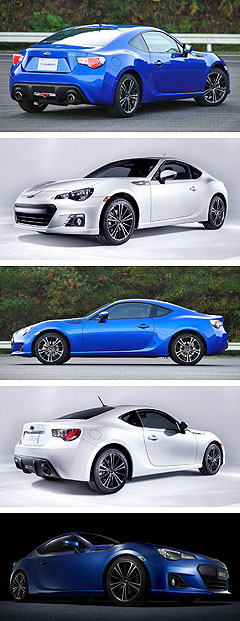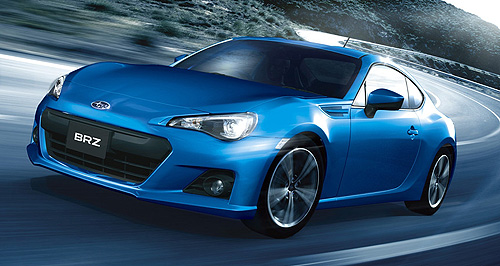Future models - Subaru - BRZTokyo show: Subaru’s BRZ breaks coverShadow boxer: Subaru's production-ready BRZ coupe is almost identical to the co-developed Toyota 86. Subaru’s showroom BRZ goes naked – and might go topless29 Nov 2011 SUBARU has whipped the covers from its long-awaited rear-drive BRZ sports coupe – and appears to ready to whip off a bit more, with a convertible version under serious consideration. A Subaru product planning chief responsible for the BRZ told GoAuto in Japan: “Everyone who sees this coupe wants a convertible. If demand is enough, they can have it.” While Toyota is targeting a mid-2012 Australian launch for its near-identical version of the jointly developed coupe – called 86 in Toyota guise – the BRZ is still no certainty for the local market, where Subaru Australia has promised a mid-December decision. Even if the BRZ lands in Australian showrooms, fans of Subaru’s trademark symmetrical all-wheel drive should not hold their breath for an all-paw variant of the sportscar, as a front differential simply will not fit under the nose where the all-new 147kW 2.0-litre FA ‘boxer’ engine has been pushed as low as possible to drive down the centre of gravity. Nor should they hanker for a turbocharged BRZ any time soon, with the Subaru engineer revealing at a special pre-show preview for the car in Japan that such a move would be “difficult because of the (engine) packaging”.  “It was not wanted, anyway,” he said, adding that the development team wanted linear power delivery with “a rev-happy nature”. Instead of raw power, the main development objective of the BRZ and the closely related Toyota 86 that is also being shown in Tokyo was to create “an entertaining sportscar” under the mantra: “Pure handling delight.” The joint project grew from a single meeting between product chiefs of Toyota, Subaru and Daihatsu in 2008 to discuss sharing of products and technology. Among the projects put on the table was a pure-bred sports coupe to inject some excitement back into the Toyota range – and give Subaru another string to its high-performance bow, alongside its formidable Impreza-based all-wheel-drive turbocharged WRX and STI. It was agreed that Toyota would manage the product planning and styling of the proposed coupe – codenamed 086A – while Subaru would be responsible for the engineering and production. It was also agreed to design the car from scratch, with an all-new platform and drivetrain, including a specially developed Subaru-style boxer engine using Toyota’s latest D-4S dual-injection fuel delivery system that has both direct and port injectors for maximum performance across the rev range while delivering low fuel consumption. The engine to be used in both the BRZ and Toyota 86 is identical, right down to the joint Toyota-Subaru engine cover in both models. The DOHC (double overhead camshaft) flat-four has square cylinder dimensions (86mm x 86mm) and a high 12.5:1 compression ratio, pumping out 147kW of power at 7000rpm. While torque seems relatively modest at 205Nm at a high 6000rpm, Subaru engineers say the delivery is “much better than any other 2.0-litre naturally aspirated engine”. No performance figures have been given from either manufacturer to date, but the 0-100km/h sprint is rumoured to take about 6.5 seconds. One of the fundamentals of the BRZ-86 is the engine placement – low and as far back as possible behind the front axle – giving the car one of the lowest centres of gravity of any mass-produced car. The plan caused a number of engineering challenges, including how to fit the steering gear. Electric power steering was adopted, but Subaru says even that solution took creative thinking. The result is, according to one insider, “not a speed car – a fun-to-drive car” that causes those who drive it to fall under its spell. “Even people at Subaru who were negative towards the car fell in love with it,” an engineer said. “It was the same at Toyota.” The BRZ’s dimensions are also identical to the Toyota 86, at 4240mm long, 1775mm wide and 1285mm high, with all major metal panels – including the lightweight aluminium bonnet – a match. Minus the big rear wing of the BRZ STI concept shown at the recent Los Angeles auto show, the body is largely unadorned, except for a couple of vents on the front fenders and turning lamps in the wheelarches. The major differences between the Toyota and Subaru variants are in the plastic bits – the bumpers, grille and side-skirts – and the lights front and rear. The BRZ’s nose is dominated by a matte black bumper protruding from the grille and metallic strips across the main air opening. While the Toyota 86 gets 18-inch wheels on its launch car, the Subaru version gets 17-inch alloys – and noticeable gaps around the wheelarches. The smaller wheels are clearly against the wishes of the Subaru development team, one of which quietly expressed disappointment at what he regarded as a design mistake. A rear ducktail on the boot and a centre reversing light is common with the Toyota 86, while the BRZ gets two big-bore polished alloy exhaust tips. The BRZ and 86 will also share the same colour palette, except for an extra ‘WRC’ blue for Subaru. The two doors are frameless – a possible nod to a future convertible in the range. The six-speed manual and automatic transmissions were supplied by Japanese supplier Aisin – 30 per cent owned by Toyota – while the differential driving the rear wheels is from the Toyota stable and one of the few carryover parts from existing models. While the BRZ is theoretically a four-seater, the lack of rear legroom most definitely puts it in the 2+2 class. However, Subaru says the rear space is at least superior to that of the Audi TT, which it regards as one of BRZ’s competitors, along with the Mazda MX5. The BRZ interior is decked out in a two-tone charcoal-black colour scheme, with new lightweight sports seats sheathed in black leather with suede inserts. Red contrast stitching helps to lift the ambience, as does a silver metallic trim on the dash. Behind the chunky sports steering wheel (with gearchange paddles on the auto version), the tachometer dominates the instruments, with a small speedo to the left. The rear seat folds completely flat, opening up a handy cargo area from the boot capable of carrying larger items such as golf bags – or four complete wheels with competition tyres for track days. The boot space is enhanced by the lack of a spare wheel a can of puncture repair goo is supplied instead.  Read more27th of November 2011  First look: Toyota presents all-new ‘86’ coupeToyota’s sleek new rear-drive 86 boxer coupe revealed in final production guise17th of November 2011  LA show: Subaru sheds more light on BRZSubaru BRZ coupe concept points to superficial differences with Toyota 86 twin2nd of November 2011  LA show: Subaru lays bare BRZ STIRange-topping STI concept version of Subaru’s rear-drive BRZ coupe breaks out |
Click to shareMotor industry news |















Facebook Twitter Instagram